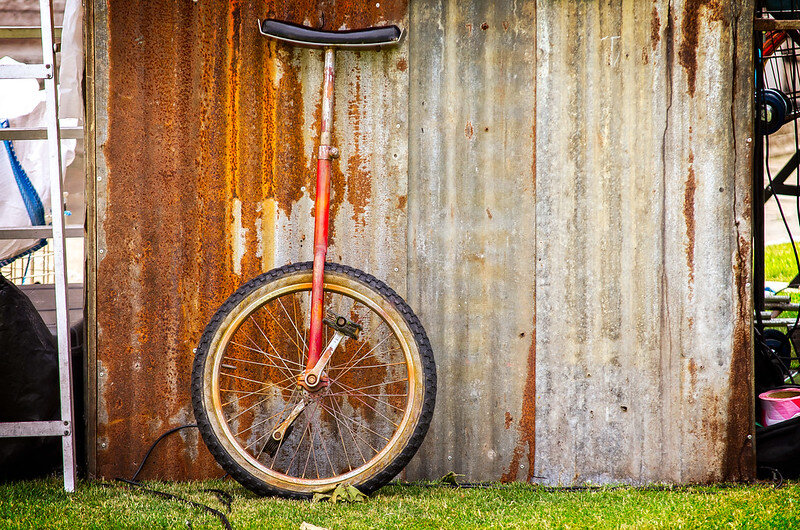How one wheel sparked a cultural change
I was running through Whittier Heights, my old neighborhood in North Seattle, the other day and I noticed a strange sight. There were small groups of kiddos (sibling groups, I guessed, each valiantly trying to maintain social distance) flocking around the quiet street together… on unicycles.
“Unicycles. Huh?”
Yes, indeed. Huh?
I happen to know exactly why they were on their one-wheeled contraptions. In fact, I know that they represent a mere fraction of the unicycle-riding population in the neighborhood.
So, why?! From where do these the unicenti emerge?
Dear reader, it’s a fun story from which we can draw a couple of lessons.
First let’s talk about things that don’t cause uni-monomania:
-
Families don’t self-select into this neighborhood because of their love of unicycles.
-
There’s no screening process that requires unicycle skills to live there.
-
There’s no nearby circus or professional reason that would prompt unicycle-oriented parents to live in this neighborhood.
The real explanation is, at once, simple and nuanced: Mr. Pule, the physical education teacher at Whittier Elementary School, runs a unicycle program.
According to the school website, “Whittier has a strong unicycle tradition, with Mr. Pule and experienced riders bringing new riders into the fold all year long…. In the 2018-19 school year, Whittier has 135 riders with 178 being our record. Level One riders earn our unicycle shirt: One Wheel To Rule Them All.”
OK, so that’s the simple explanation. But when we dig deeper, it gets more interesting on a couple of different levels.
One is the path dependency. It would be hard to start, de novo, a robust unicycle program. Whittier, though, has an august history of unicycling, so a new student entering the school will automatically be exposed to peers unicycling.
Not only do those peers provide technical assistance (“Don’t fall off,” “Here’s how you get on,” etc.), the very presence of other unicyclists normalizes the activity. One mental model of humans is that we each have an internal threshold we use to decide whether to participate in an activity. At Whittier, the population of unicyclers exceeds that internal threshold for a given new kid to try the activity. With the arrival of a new kid, the pool of unicyclists is expanded, which clears the internal bar for yet another kid to try, creating an upward spiral of adoption.
The other aspect of adoption is the systems and technologies that are in place to support it. At Whittier, unicycling is an easy default option. If the school suddenly lost its supply of unicycles, however, the program would be dead after only a short time. Even if the school introduced slightly more resistance (say, kids had to walk to a nearby building to check out a unicycle), then that friction would make adoption much harder.
I’ve been thinking about these ideas because of the cultural change and innovation efforts I’m supporting with the thoughtful Modern Legal group at Microsoft. But they apply really broadly. Here’re a few takeaways:
It’s about the people: Creating a culture (of unicyclists or innovators) is about the people.
If you’re already embedded in the culture you want, you can think about how to optimize around the margins. But if you’re working on cultural change, don’t try and do everything at once. Choose people who are likely to be early adopters (something you can identify through their social networks and by how they use existing tools) and create champions out of them.
Tell stories and normalize failure: Shepherding adoption is not just about the numbers. Sharing stories of successes (and the inevitable failures along the way) will create a safe space and facilitate experimentation.
In the next iteration, use the stories of early adopters to engage people with a slightly higher internal threshold. Soon (a relative term — it could take years!), you’ll reach people who want to adopt because they fear being left behind.
Change agents model change: As someone seeking change, you’ll be asking people to do things differently. It can be helpful to remember that you’re embedded in the organization: if you approach the work in a way that feels comfortable, you’ll get the same results.
So invite yourself to try new things and to take risks. Not only will this yield different outcomes, but you’ll also model the very experimentation you’re trying to facilitate.
Create systems: Without unicycles, you can have no unicyclists. Make the tools and resources needed to support your culture easy to find and simple to use. If you’re using technology to innovate, for example, it should be accessible. Meet your people where they are; don’t make them walk to you.
Are there change efforts that you’ve been a part of? Is there a part of your culture that you’re working to change right now?

